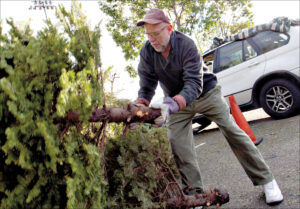 MAIN LIBRARY — Santa Monica's 2012 Sustainability Report Card shows that the city is a B student with a straight-A work ethic when it comes to its efforts to improve sustainability and provide its residents access to housing and other requirements.
MAIN LIBRARY — Santa Monica's 2012 Sustainability Report Card shows that the city is a B student with a straight-A work ethic when it comes to its efforts to improve sustainability and provide its residents access to housing and other requirements.
The Office of Sustainability and the Environment (OSE) released its sixth report card Thursday morning, and showed a consistent score or incremental improvement in each of eight categories spelled out in City Hall's Sustainable City Plan.
Overall, independent consultant Sally Livingston gave the city a 3.0 grade point average on its actual performance in the categories of resource conservation (B), environmental and public health (C+), transportation (B-), economic development (B), open space and land use (A-), housing (C), civic participation (A-) and human dignity (B+).
The report card also includes a second grade for effort, which, when combined with the performance scores, brings the total GPA up to a respectable 3.4.
The City Council recently added a ninth category — arts and culture — but staff are still working out the benchmarks by which they can measure success or failure, said Shannon Parry, assistant director of OSE.
If the GPA seems low — Santa Monica is often noted as one of the most sustainable cities in the country, recently winning the national Siemens Sustainable Community Award — it's because the standards are so high, said Dean Kubani, director of the OSE.
"Beyond simply reporting grades, the report card is an opportunity to share some of the remarkable achievements made in the last year," Kubani said.
City Hall improved its scores in three of the eight categories: Resource conservation, transportation and human dignity.
Resource conservation jumped up from B- to a B because of reduced water use, improved waste diversion rates, increases in community renewable energy use and the increased access to local water supply.
A newly-expanded food waste composting program kept more than 4 million pounds of food waste out of the landfill, and water demand has decreased by 14 gallons per person per day as a result of more than 700 water-saving devices installed in homes and businesses throughout the city, according to the report.
An increase in the amount of carpoolers, residents taking the Big Blue Buses and improved bicycle facilities led to an improvement from a C+ in 2011 to a B- in the realm of transportation, and the more ephemeral concept of "human dignity" rose from a B to a B+ in part because of the success of homeless programs in Santa Monica.
"I think this is a real sign of a caring community," Parry said.
Civic participation and open space held steady from the previous year with the highest scores awarded, an A-.
Civic participation, paired with community education, was almost a "gimmee" category for Santa Monica. That score is based on the participation in major community events and civic affairs.
Voter turnout in November 2010, an off year, came in at 65 percent, exceeding City Hall's 50 percent target.
Tens of thousands flock to local festivals and alternative vehicle and building shows, and 600,000 were drawn in by Bergamot Station, according to the report.
Land use and open space stayed strong as well thanks to a new program that's resulted in 1,384 new trees added to Santa Monica's urban forest and the fact that 90 percent of residents live within a half mile of open space.
City Hall isn't done, however — they want that to be cut down to a quarter mile, Parry said.
Economic development held onto its B grade. Strong performance in terms of job creation and diversification of industries was hampered by the rising cost of living and unbalanced ratio of jobs to housing, which makes it hard for people to live near where they work.
City Hall had a "needs improvement" in two categories — environmental and public health and housing, both of which got a C+.
Although water quality improved in the oceans and thousands of pounds of hazardous waste and materials were collected, there are still ongoing issues with environmental health that brought the low grade.
The problems with housing focused mainly on affordability, particularly given the fact that over 60 percent of rent-controlled housing in the city has had its rents raised to market rate.
The loss of Santa Monica's Redevelopment Agency, the leading funder of affordable housing production in the city, didn't help.
The last two categories illustrate one of Parry's last points in her presentation. Although Santa Monica has work to do, many of its remaining challenges stem from causes outside of the city limits.
"The reality is we're never going to become a sustainable island," Kubani said. "Even if we did and the rest of the area goes down in flames, we'll end up going down in flames too. Part of our goal of getting to sustainability involves encouraging others … to help work and move in that direction."
ashley@www.smdp.com









